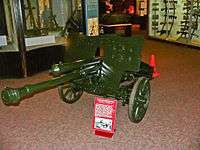4,7cm KPÚV vz. 38
| 4,7cm KPÚV vz. 38 | |
|---|---|
|
In the United States Army Ordnance Museum | |
| Type | Anti-tank gun |
| Place of origin | Czechoslovakia |
| Service history | |
| Used by |
Czechoslovakia Nazi Germany Kingdom of Yugoslavia |
| Wars | World War II |
| Production history | |
| Designed | 1936 |
| Manufacturer | Škoda Works |
| Produced | 1939-1940 |
| Specifications | |
| Weight | 590 kg (1,300 lbs) |
| Barrel length | 2.04 m (6 ft 8 in) L/43 |
| Crew | ? |
|
| |
| Shell | 47×405 mm. R |
| Caliber | 47 mm (1.85 in) |
| Carriage | split trail |
| Elevation | -8° to +26° |
| Traverse | 50° |
| Muzzle velocity | 775 m/s (2,542 ft/s) |
| Maximum firing range | 4,000 m (4,375 yds) |
The 4,7cm KPÚV vz. 38 (Czech: kanón proti útočné vozbě vzor 38) was an anti-tank gun produced by the Škoda Works that saw service in World War II. Originally designed for the Czechoslovak Army, some were also sold to Yugoslavia. A number were appropriated by the Germans after the German occupation of Czechoslovakia in 1939 and used under the designations 4.7 cm Pak (t) or Pak 38(t). The Germans continued it in production and mounted it on the Panzerkampfwagen I chassis as the Panzerjäger I tank destroyer. A similar attempt to mount it on the chassis of captured Renault R-35 tanks was less successful.[1]
The barrel had the unique feature of being able to swing 180° so the barrel lay flat over the trails for transport and the outer part of the trails could be also folded inward to reduce its size. The gun had a small shield and wooden-spoked wheels. Although rather elderly-looking, its performance was superior to most contemporary designs and the gun was armed with both AP rounds and HE rounds for infantry support.
Armor penetration
- 60 mm (2.4 in) @ 1,200 metres (1,300 yd) @ 90°,100 metres 92mm @90°
Notes
- ↑ Jentz, pp. 62–63
References
- Gander, T.J. German Anti-tank Guns 1939-1945, Almark Publications, 1973. ISBN 0-85524-142-X (soft cover)
- Gander, Terry and Chamberlain, Peter. Weapons of the Third Reich: An Encyclopedic Survey of All Small Arms, Artillery and Special Weapons of the German Land Forces 1939-1945. New York: Doubleday, 1979 ISBN 0-385-15090-3
- Hogg, Ian.Twentieth-Century Artillery, Barnes & Noble Books, 2000. ISBN 0-7607-1994-2
- Janoušek, Jiří. Československé dělostřelectvo 1918-1939, Corona, 2007. ISBN 978-80-86116-34-1
- Jentz, Thomas L. Panzerjaeger (3.7 cm Tak to Pz.Sfl.Ic): Development and Employment from 1927 to 1941 (Panzer Tracts No. 7-1) Boyds, MD: Panzer Tracts, 2004. ISBN 0-9744862-3-X
| Wikimedia Commons has media related to Škoda 47 mm Model 1938. |


